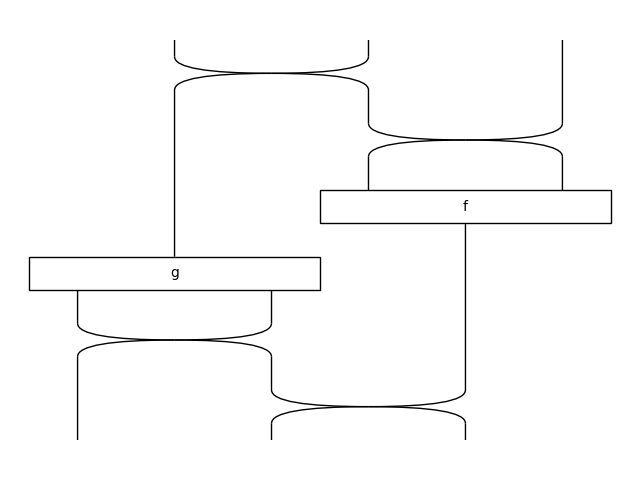Diagram#
- class discopy.symmetric.Diagram(inside, dom, cod, _scan=True)[source]#
Bases:
discopy.balanced.DiagramA symmetric diagram is a balanced diagram with
Swapboxes.- Parameters:
inside (Layer) – The layers inside the diagram.
dom (monoidal.Ty) – The domain of the diagram, i.e. its input.
cod (monoidal.Ty) – The codomain of the diagram, i.e. its output.
Note
Symmetric diagrams have a class property use_hypergraph_equality, that changes the behaviour of equality and hashing. When set to False, two diagrams equal if they are built from the same layers. When set to True, the underlying hypergraphs are used for hashing and equality checking. The default value of use_hypergraph_equality is False.
>>> x, y = Ty("x"), Ty("y") >>> id_hash = hash(Id(x @ y)) >>> assert Swap(x, y) >> Swap(y, x) != Id(x @ y) >>> with Diagram.hypergraph_equality: ... assert Swap(x, y) >> Swap(y, x) == Id(x @ y) ... assert id_hash != hash(Id(x @ y))
Note
Symmetric diagrams can be defined using the standard syntax for functions.
>>> x = Ty('x') >>> f = Box('f', x @ x, x) >>> g = Box('g', x, x @ x)
>>> @Diagram.from_callable(x @ x @ x, x @ x @ x) ... def diagram(x0, x1, x2): ... x3 = f(x2, x0) ... x4, x5 = g(x1) ... return x5, x3, x4 >>> diagram.draw(draw_type_labels=False, ... path='docs/_static/symmetric/decorator.png')

Every variable must be used exactly once or this will raise an error.
>>> from pytest import raises >>> from discopy.utils import AxiomError
>>> with raises(AxiomError) as err: ... Diagram.from_callable(x, x @ x)(lambda x: (x, x)) >>> print(err.value) symmetric.Diagram does not have copy or discard.
>>> with raises(AxiomError) as err: ... Diagram.from_callable(x, Ty())(lambda x: ()) >>> print(err.value) symmetric.Diagram does not have copy or discard.
Note
As for
discopy.balanced.Diagram, our symmetric diagrams are traced by default. However now we have that the axioms for trace hold on the nose.- classmethod swap(left, right)[source]#
The diagram that swaps the
leftandrightwires.- Parameters:
- Return type:
Note
This calls
balanced.hexagon()andbraid_factory.
- permute(*xs)[source]#
Post-compose with a permutation.
- Parameters:
xs (int) – A list of integers representing a permutation.
- Return type:
Examples
>>> x, y, z = Ty('x'), Ty('y'), Ty('z') >>> assert Id(x @ y @ z).permute(2, 0, 1).cod == z @ x @ y
- depth()[source]#
The depth of a symmetric diagram.
Examples
>>> x = Ty('x') >>> f = Box('f', x, x) >>> assert Id(x).depth() == Id().depth() == 0 >>> assert f.depth() == (f @ f).depth() == 1 >>> assert (f @ f >> Swap(x, x)).depth() == 1 >>> assert (f >> f).depth() == 2 and (f >> f >> f).depth() == 3
- trace_factory#
alias of
Trace